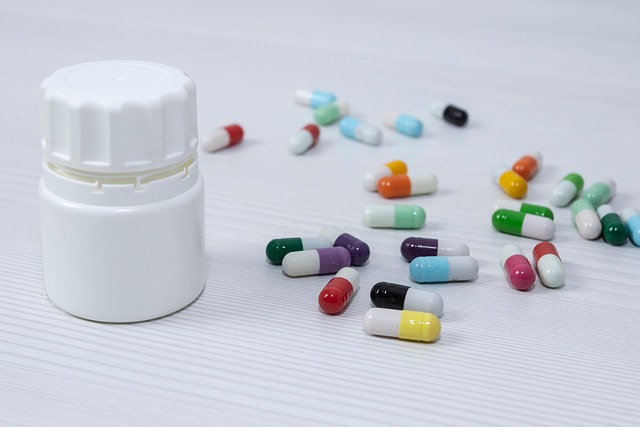GLP-1 drugs mimic natural intestinal hormones to manage type 2 diabetes and weight. They stimulate insulin release, suppress glucagon, reduce appetite, and offer cardiovascular benefits. With ongoing research focusing on efficacy, duration, delivery systems, and combinations, GLP-1 drugs are revolutionizing diabetes treatment towards personalized care.
“GLP-1 receptor agonists, a class of innovative diabetes medications, have emerged as powerful tools in managing blood sugar levels. This article delves into the intricate mechanism of action behind these GLP-1 drugs, exploring how they mimic natural intestinal hormones. By enhancing insulin secretion and suppressing glucagon, these agonists achieve remarkable effects on glycemic control. Furthermore, we discuss their role in weight management through appetite regulation and highlight cardiovascular benefits. The future prospects of GLP-1 receptor agonists in diabetes treatment offer promising advancements for patients.”
GLP-1 Receptor Agonists: Basic Mechanism

GLP-1 receptor agonists are a class of medications designed to mimic the effects of the natural hormone glucagon-like peptide-1 (GLP-1), which plays a key role in regulating blood sugar levels. These drugs bind to and activate GLP-1 receptors on specific cells, primarily those in the pancreas and gut. This activation triggers a cascade of physiological responses.
Firstly, GLP-1 receptor agonists stimulate insulin secretion from beta cells in the pancreas in a glucose-dependent manner, helping to lower blood sugar levels. They also slow gastric emptying, which gives the body more time to process food and absorb nutrients, further contributing to glycemic control. Additionally, these drugs have been shown to reduce appetite and increase feelings of fullness, making them valuable tools in managing weight and type 2 diabetes. The basic mechanism of action thus involves a combination of enhancing insulin release, delaying digestion, and suppressing appetite, all of which work synergistically to stabilize blood sugar levels.
How These Drugs Mimic Intestinal Hormones

GLP-1 receptor agonists mimic the action of natural intestinal hormones called glucagon-like peptide-1 (GLP-1). These hormones are released in response to food, particularly carbohydrates and proteins. They play a crucial role in regulating blood sugar levels by stimulating insulin secretion from the pancreas when glucose levels rise.
The drugs used in this class replicate these effects, binding to GLP-1 receptors on pancreatic cells. This binding triggers a cascade of events that enhance insulin release and suppress glucagon release, thereby improving glycemic control. By mimicking the natural mechanisms of GLP-1, these drugs offer an effective treatment option for type 2 diabetes, helping to manage blood sugar levels and promote overall metabolic health.
Enhancing Insulin Secretion and Suppressing Glucagon

GLP-1 receptor agonists play a dual role in regulating blood glucose levels. They significantly enhance insulin secretion in response to food, particularly carbohydrates. This effect is achieved by stimulating beta cells in the pancreas to release insulin, which promotes glycemic control by facilitating glucose uptake into cells.
At the same time, these drugs suppress glucagon secretion from alpha cells. Glucagon normally increases blood sugar levels by promoting liver glycogen breakdown and inhibiting insulin’s effects. By blocking glucagon release, GLP-1 drugs help maintain a balance in glucose homeostasis, further contributing to improved glycemic control and reduced risk of hyperglycemia.
Weight Management Through Appetite Regulation

One of the key mechanisms by which GLP-1 receptor agonists exert their therapeutic effects is through appetite regulation. These drugs mimic the actions of the natural hormone GLP-1, which signals to the brain that the stomach is full, leading to a reduction in food intake and subsequent weight loss. By activating specific receptors in the brain, GLP-1 drugs help control hunger pangs and cravings, making it easier for individuals to stick to healthy eating habits.
This appetite-suppressing effect is particularly beneficial for managing obesity. Clinical studies have shown that GLP-1 receptor agonists can lead to significant weight loss when combined with a balanced diet and increased physical activity. The ability of these drugs to curb excessive eating contributes to their effectiveness in treating type 2 diabetes and metabolic disorders, ultimately improving overall health outcomes.
Cardiovascular Benefits and Safety Profile

GLP-1 receptor agonists, a class of drugs mimicking the effects of the natural hormone GLP-1, offer significant cardiovascular benefits. These medications have been shown to reduce major adverse cardiovascular events (MACE), including heart attacks and strokes, in high-risk patients with type 2 diabetes or established cardiovascular disease. The mechanisms behind these benefits include improved blood pressure control, enhanced vascular function, and reduced inflammation.
In terms of safety, GLP-1 drugs are generally well-tolerated. Common side effects are mild and often related to gastrointestinal disturbances, such as nausea and vomiting, but these tend to be transient and less frequent with continued use. More serious adverse events are rare, and the overall safety profile makes GLP-1 agonists an attractive option for chronic management of cardiovascular risk factors, especially in combination with other evidence-based therapies.
Future Perspectives in Diabetes Treatment

The future of diabetes treatment looks promising with GLP-1 receptor agonists as a prominent player. Ongoing research focuses on improving existing GLP-1 drugs to enhance their efficacy and duration of action, potentially offering more convenient dosing regimens for patients. One avenue of exploration is the development of long-acting injectables, aiming to mimic the natural rhythms of insulin secretion, thereby reducing the need for frequent injections. Additionally, combining GLP-1 therapies with other diabetes medications or novel drug classes could lead to synergistic effects and better glycemic control. With advancements in technology, targeted drug delivery systems are also under investigation, allowing for more precise control over hormone release and potentially lessening side effects. These innovations hold the key to transforming diabetes management into a more seamless and personalized experience.
